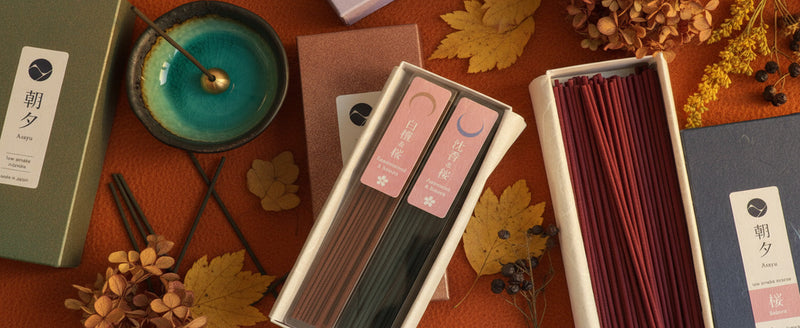
How is Japanese Incense Made and Preserved? : Awaji Island

The Tradition of Incense in Japan
In the diversity of sense, one often overlooked is the smell. While sight, sound, and taste frequently steal the spotlight, scent is less popular. Its evanescent nature, coupled with the absence of a standardized vocabulary, makes it often forgotten.
In modern life, our daily experiences are more stimulating for sight and sound than for smell. However, smell is a powerful sense that can evoke memories and moments from our past. Despite its potential benefits, we less frequently rely on it. Yet, incorporating fragrances into our lives can have a positive impact on our well-being.
However, delving into olfactory cultural production unveils a realm of significance. Be it cultural, economic, or spiritual. Intertwined with daily life and ceremonial practices, the art of incense comes from a long heritage of history and craftmanship.
The history of incense in Japan is as ancient as the civilization itself. Click here for an article on the Origins of Japanese Incense. Initially a luxury commodity sourced from India and China, incense evolved into an integral aspect of Japanese culture. It was used for diverse purposes ranging from ritual offerings to masking odors and communicating with the divine. Japanese incense is varied and rich, reflecting the deep social and cultural significance it holds within the society. This diversity stems from its use in religious ceremonies, meditation, and daily life, where it plays an integral role in enhancing spiritual and sensory experiences. Like Ikebana or tea ceremony, it has masters, afficionados and casual enthusiast. Incense also got its own ceremonies or dedicated games.
Continuity from the origins : example of Awaji Island
With its roots tracing back to the very beginnings of incense in Japan. Awaji Island, nestled in the Inland Sea, near Osaka, emerged as one of the original provider for high quality craft made incense.
It was from Sakai incense firms, situated near Osaka, that Awaji fishermen originally learned how to make incense in or around 1850. It allowed them to earn a living during the winter months when rough seas prevented their fishing boats from leaving harbor.

For a very long time, Awaji incense makers did not produce their own incense. They made basic cedar needle incenses as orders from mainland, which they would ship to incense firms on the other side of Osaka Bay.
They took advantage of this trade to learn about and start their own production. They were able to use their own fishing boats to ship home the raw materials. The number of manufacturer established in Awaji island grew up exponentially reaching up to fifteen within 1870 and 1900.
Awaji Island provided not only cheaper lands compared to the mainland, but also a unique advantage for incense manufacturing, its strong wind in winter. In the past, incense needed to dry for 20 days before it could be used, so the island's winter wind was truly a blessing.
This is how relying on incense manufacturing both helped Awaji population of this time and planted the roots of the only remaining Japanese incense’s production site nowadays.
The Art of Incense Craftmanship - How incense is made
Venturing into an Awaji Island incense manufacturer's domain unveils a meticulous process, where every step is imbued with tradition and expertise. Production begins with sourcing raw materials, ranging from aromatic woods to fragrant oils, meticulously blended and kneaded to perfection. The expertise lies in balancing factors like scent strength, material quantity, and heat. Ensuring a harmonious blend that unfolds its essence upon burning.
Raw and heated ingredients can be quite different as well. A material’s smell cannot be judged on its raw smell only and need to be burned for a correct judgement. The smell can also change during the burning course, because different ingredients burn at different rates. The challenge lies in ensuring that the scent experienced during blending matches the aroma produced when the incense is burned.

Incense blenders must possess a profound understanding of each ingredient's precise quantities required, in order to create the desired scent.
The kneaded materials are then shaped into incense sticks, cones, or spirals, with precise dimensions dictating burning time and fragrance dispersion.
From Tradition to Innovation
Historically catering primarily to Buddhist rituals, the evolution of leisure-related fragrances marked a significant shift for incense crafters. Leveraging consumer preferences, manufacturers diversified their offerings.
This can be seen as transformation from traditionally honoring the dead to honoring the living in modern shift from o-kō Buddhist incense to o-senkō leisure incense usage.
Nowadays, about 70 per cent of Japan’s production of incense is from Awaji island. With the evolution of traditional society to modern, craftsmen had to adapt. The traditional strong-smelling temple incense had to shift to a lighter, suited to small places, scent.
Beyond the Scent: a partnership
At Asayu, we strive to share this legacy with the world. Some of our curated selection of incense comes from Awaji Island offers a diverse range of fragrances, each one evoking a distinct emotion or memory. From the calming notes of sandalwood to the invigorating essence of citrus, our incense allows you to create a personalized well-balanced sanctuary within your own home.

Let the delicate smoke of Asayu Japan transport you on a journey to the origins of Japan. Breathe in the tranquility, embrace the rich heritage, and discover the profound peace that lies at the heart of this ancient practice still fundamental in our modern lives.


